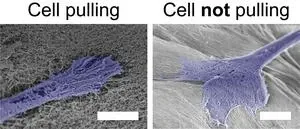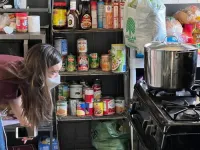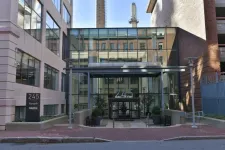(Press-News.org) Research led by scientists at the Department of Energy’s Oak Ridge National Laboratory has demonstrated that small changes in the isotopic content of thin semiconductor materials can influence their optical and electronic properties, possibly opening the way to new and advanced designs with the semiconductors.
Partly because of semiconductors, electronic devices and systems become more advanced and sophisticated every day. That’s why for decades researchers have studied ways to improve semiconductor compounds to influence how they carry electrical current. One approach is to use isotopes to change the physical, chemical and technological properties of materials.
Isotopes are members of a family of an element that all have the same number of protons but different numbers of neutrons and thus different masses. Isotope engineering has traditionally focused on enhancing so-called bulk materials that have uniform properties in three dimensions, or 3D. But new research led by ORNL has advanced the frontier of isotope engineering where current is confined in two dimensions, or 2D, inside flat crystals and where a layer is only a few atoms thick. The 2D materials are promising because their ultrathin nature could allow for precise control over their electronic properties.
“We observed a surprising isotope effect in the optoelectronic properties of a single layer of molybdenum disulfide when we substituted a heavier isotope of molybdenum in the crystal, an effect that opens opportunities to engineer 2D optoelectronic devices for microelectronics, solar cells, photodetectors and even next-generation computing technologies,” said ORNL scientist Kai Xiao.
Yiling Yu, a member of Xiao’s research team, grew isotopically pure 2D crystals of atomically thin molybdenum disulfide using molybdenum atoms of different masses. Yu noticed small shifts in the color of light emitted by the crystals under photoexcitation, or stimulation by light.
“Unexpectedly, the light from the molybdenum disulfide with the heavier molybdenum atoms was shifted farther to the red end of the spectrum, which is opposite to the shift one would expect for bulk materials,” Xiao said. The red shift indicates a change in the electronic structure or optical properties of the material.
Xiao and the team, working with theorists Volodymyr Turkowski and Talat Rahman at the University of Central Florida, knew that the phonons, or crystal vibrations, must be scattering the excitons, or optical excitations, in unexpected ways in the confined dimensions of these ultrathin crystals. They discovered how this scattering shifts the optical bandgap to the red end of the light spectrum for heavier isotopes. “Optical bandgap” refers to the minimum amount of energy needed to make a material absorb or emit light. By adjusting the bandgap, researchers can make semiconductors absorb or emit different colors of light, and such tunability is essential for designing new devices.
ORNL’s Alex Puretzky described how different crystals grown on a substrate can show small shifts in emitted color caused by regional strain in the substrate. To prove the anomalous isotope effect and measure its magnitude to compare with theoretical predictions, Yu grew molybdenum disulfide crystals with two molybdenum isotopes in one crystal.
“Our work was unprecedented in that we synthesized a 2D material with two isotopes of the same element but with different masses, and we joined the isotopes laterally in a controlled and gradual manner in a single monolayer crystal,” Xiao said. “This enabled us to observe the intrinsic anomalous isotope effect on the optical properties in the 2D material without the interference caused by an inhomogeneous sample.”
The study demonstrated that even a small change of isotope masses in the atomically thin 2D semiconductor materials can influence optical and electronic properties — a finding that provides an important basis for continued research.
“Previously, the belief was that to make devices such as photovoltaics and photodetectors, we had to combine two different semiconductor materials to make junctions to trap excitons and separate their charges. But actually, we can use the same material and just change its isotopes to create isotopic junctions to trap the excitons,” Xiao said. “This research also tells us that through isotope engineering, we can tune the optical and electronic properties to design new applications.”
For future experiments, Xiao and the team plan to collaborate with the experts at the High Flux Isotope Reactor and the Isotope Science and Engineering Directorate at ORNL. These facilities can provide various highly enriched isotope precursors to grow different isotopically pure 2D materials. The team can then further investigate the isotope effect on spin properties for their application in spin electronics and quantum emission.
The paper describing the research is published in Science Advances.
This work was supported by DOE’s Office of Science, Basic Energy Sciences, Materials Sciences and Engineering Division and was performed at the Center for Nanophase Materials Sciences, or CNMS, at ORNL, an Office of Science user facility. The CNMS supported the TOF-SIMS, STEM and optical spectroscopy measurements.
UT-Battelle manages ORNL for DOE’s Office of Science. The single largest supporter of basic research in the physical sciences in the United States, the Office of Science is working to address some of the most pressing challenges of our time. For more information, please visit energy.gov/science. — Scott Gibson
END
Tweaking isotopes sheds light on promising approach to engineer semiconductors
2024-05-03
ELSE PRESS RELEASES FROM THIS DATE:
How E. coli get the power to cause urinary tract infections
2024-05-03
Through a quirk of anatomy, women are especially prone to urinary tract infections, with almost half dealing with one at some point in their lives.
Scientists have been trying to figure out for decades how bacteria gain a foothold in otherwise healthy people, examining everything from how the microbes move inside and stick to the inside of the bladder to how they deploy their toxins to produce uncomfortable and often painful symptoms.
Research published in PNAS examines how the bacteria Escherichia coli, or E. coli—responsible for most UTIs—is able to use host nutrients to reproduce at an extraordinarily rapid pace during ...
Quantifying U.S. health impacts from gas stoves
2024-05-03
Households with gas or propane stoves regularly breathe unhealthy levels of nitrogen dioxide, a study of air pollution in U.S. homes found.
“I didn’t expect to see pollutant concentrations breach health benchmarks in bedrooms within an hour of gas stove use, and stay there for hours after the stove is turned off,” said Stanford Doerr School of Sustainability Professor Rob Jackson, senior author of the May 3 study in Science Advances. Pollution from gas and propane stoves isn’t just an issue for cooks or people in the kitchen, ...
Physics confirms that the enemy of your enemy is, indeed, your friend
2024-05-03
Most people have heard the famous phrase “the enemy of my enemy is my friend.”
Now, Northwestern University researchers have used statistical physics to confirm the theory that underlies this famous axiom.
The study will be published on May 3 in the journal Science Advances.
In the 1940s, Austrian psychologist Fritz Heider introduced social balance theory, which explains how humans innately strive to find harmony in their social circles. According to the theory, four rules — an enemy of an enemy is a friend, a friend of a ...
Stony coral tissue loss disease is shifting the ecological balance of Caribbean reefs
2024-05-03
The outbreak of a deadly disease called stony coral tissue loss disease is destroying susceptible species of coral in the Caribbean while helping other, “weedier” organisms thrive — at least for now — according to a new study published today in Science Advances.
Researchers say the drastic change in the region’s population of corals is sure to disrupt the delicate balance of the ecosystem and threaten marine biodiversity and coastal economies.
“Some fast-growing organisms, like algae, ...
Newly discovered mechanism of T-cell control can interfere with cancer immunotherapies
2024-05-03
Activated T cells that carry a certain marker protein on their surface are controlled by natural killer (NK) cells, another cell type of the immune system. In this way, the body presumably curbs destructive immune reactions. Researchers from the German Cancer Research Center (DKFZ) and the University Medical Center Mannheim (UMM) now discovered that NK cells can impair the effect of cancer therapies with immune checkpoint inhibitors (ICI) in this way. They could also be responsible for the rapid decline of therapeutic CAR-T cells. Interventions in this mechanism could ...
Wistar scientists discover new immunosuppressive mechanism in brain cancer
2024-05-03
PHILADELPHIA — (May 3, 2024) — The Wistar Institute assistant professor Filippo Veglia, Ph.D., and team, have discovered a key mechanism of how glioblastoma — a serious and often fatal brain cancer — suppresses the immune system so that the tumor can grow unimpeded by the body’s defenses. The lab’s discovery was published in the paper, “Glucose-driven histone lactylation promotes the immunosuppressive activity of monocyte-derived macrophages in glioblastoma,” in the journal Immunity.
“Our study shows that the cellular mechanisms of cancer’s self-preservation, when sufficiently understood, can be used against the disease very effectively,” ...
ADA Forsyth ranks number 1 on the East Coast in oral health research
2024-05-03
Cambridge, Mass., – ADA Forsyth Institute (AFI) researchers received just under $10 million funding from the National Institute of Dental and Craniofacial Research (NIDCR) during the federal fiscal year 2023, placing 4th nationally on NIDCR’s ranking list.
“We have ranked in the top 5 dental institutions in 9 out of the past 10 years,” said Wenyuan Shi, PhD, Chief Executive Officer of AFI. “We have placed in the top 10 nationally every year since the ranking system began in 2002, despite having one of the smallest faculty ...
The American Ornithological Society (AOS) names Judit Szabo as new Ornithological Applications editor-in-chief
2024-05-03
May 3, 2024—CHICAGO—The American Ornithological Society (AOS) is pleased to announce Judit K. Szabo, Ph.D., as the incoming editor-in-chief for its top-ranked journal, Ornithological Applications. Beginning on May 1, 2024, Szabo will work in partnership with the journal’s current editor-in-chief, Catherine Lindell, Ph.D., until June 30, 2024, and will take on full responsibility as editor-in-chief beginning on July 1, 2024. “With her international interest and network, conservation experience, and thoughtful approach ...
Catheter-directed mechanical thrombectomy system demonstrates safety and effectiveness in patients with pulmonary embolism
2024-05-03
Long Beach, Calif. – May 3, 2024 – New data from the Acute Pulmonary Embolism Extraction Trial with the AlphaVac System (APEX-AX) demonstrated that catheter-directed mechanical thrombectomy is safe and effective in patients with acute intermediate-risk pulmonary embolism (PE) with significant improvement in the right ventricle (RV) function and minimal major adverse events. The safety and efficacy results from the prospective trial were presented today as late-breaking science at the Society for Cardiovascular Angiography & Interventions (SCAI) 2024 Scientific Sessions.
Pulmonary embolism (PE), a blood clot that blocks and stops ...
Novel thrombectomy system demonstrates positive safety and feasibility results in treating acute pulmonary embolism
2024-05-03
Long Beach, Calif. – May 3, 2024 – Late-breaking data from the ENGULF trial showed that a novel dual-action thrombectomy device was effective and safe in treating acute pulmonary embolism (PE). The safety and effectiveness results were presented today as late-breaking science at the Society for Cardiovascular Angiography & Interventions (SCAI) 2024 Scientific Sessions and simultaneously published in JSCAI.
PE is a serious cardiovascular event where a blood clot causes issues with blood flow and oxygen levels in the lungs. It can be ...









